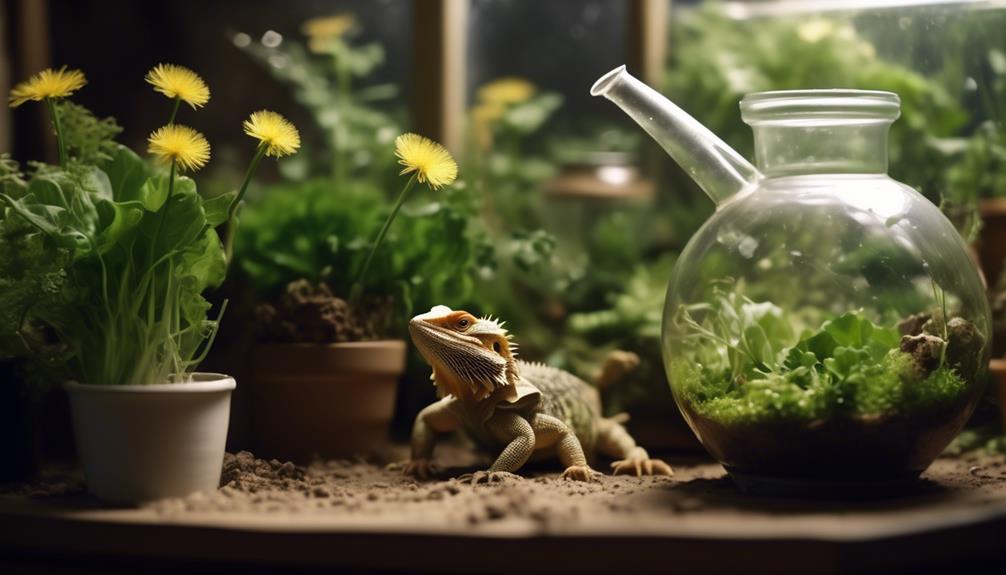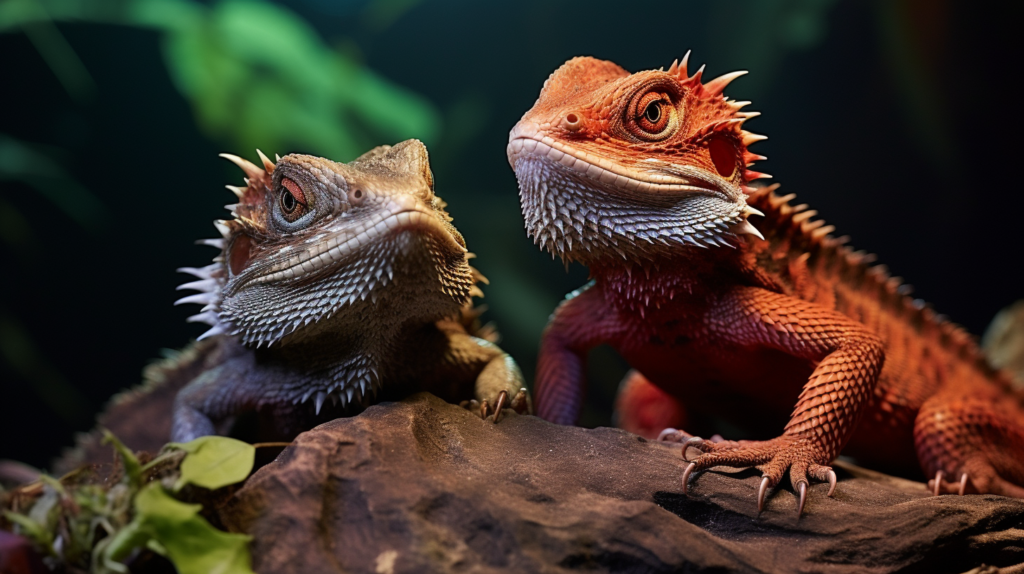Interested in incorporating dandelion greens into your bearded dragon’s diet? Surprisingly, growing them yourself is easy and provides a natural, nutritious food source for your pet.
However, before you start planting, it’s important to follow a few key steps to ensure successful growth.
Stay tuned to learn how to establish a flourishing dandelion green garden that will contribute to your bearded dragon’s happiness and health.
To grow dandelion greens for bearded dragons, choose a sunny location with well-draining, slightly acidic soil, and plant the seeds about 1/4 inch deep, watering the soil thoroughly. Harvest the greens at their peak freshness and feed them to your bearded dragon 3-4 times a week to ensure their optimal dietary benefits. This process provides a natural and nutritious food source for your pet, contributing to their happiness and health.
Selecting the Right Location
To ensure the successful growth of dandelion greens for your bearded dragons, it’s important to choose a location that receives ample sunlight, ideally at least 6 hours of direct sunlight daily. Sunlight is essential for photosynthesis, which provides the necessary energy for the plants to produce the nutrients that bearded dragons need. When selecting a location, consider the angle of the sunlight throughout the day to ensure even exposure.
Apart from sunlight, soil quality also significantly affects the successful cultivation of dandelion greens. Bearded dragons require a diet rich in calcium, and the quality of the soil directly impacts the nutrient content of the plants. It’s advisable to conduct a soil test to assess its pH levels and nutrient composition. Dandelion greens thrive in well-draining, slightly acidic soil with a pH range of 6.0 to 7.5. Make sure that the soil is loose to allow for proper root development and nutrient absorption.
Preparing the Soil
When preparing the soil for cultivating dandelion greens for your bearded dragons, it’s important to ensure that the area receives adequate sunlight and has the appropriate pH levels and nutrient composition to support the plants’ growth and nutritional value. Improving soil quality is crucial to provide your bearded dragons with high-quality dandelion greens.
Here are three practical steps to prepare the soil for optimal growth:
- Test the Soil: Utilize a soil testing kit to analyze the pH levels and nutrient composition of the soil. Dandelion greens thrive in slightly acidic to neutral soil with a pH range of 6.0 to 7.5. Adjust the pH levels as necessary by adding lime to raise the pH or elemental sulfur to lower it, ensuring the soil falls within the ideal range for dandelion growth.
- Amend the Soil: Integrate organic matter such as compost or well-rotted manure into the soil to enhance its structure and fertility. This will supply essential nutrients and improve the soil’s capacity to retain moisture, fostering healthy dandelion growth.
- Pest Control: Before planting, inspect the soil for any signs of pests or diseases. Remove any unwanted vegetation and ensure the area is free from pests that could potentially harm the dandelion greens. Consider employing natural pest control methods to maintain a healthy growing environment for your bearded dragons’ preferred greens.
Planting Dandelion Seeds
Dandelion seeds thrive in well-draining soil that gets plenty of sunlight and has a neutral to slightly acidic pH level, which is ideal for growing the preferred greens for your bearded dragons.
Prepare the soil by ensuring it’s loose and free from debris to aid in seed germination. Plant the seeds about 1/4 inch deep in the soil, spacing them approximately 2 inches apart. Gently cover the seeds with soil and press them down lightly for good seed-to-soil contact. Water the soil thoroughly, making sure not to overwater, as dandelion seeds need moisture for germination but may rot if the soil is too wet.
Sunlight is essential for the germination of dandelion seeds, so place the planting container in a spot that receives at least 6-8 hours of sunlight each day. If using grow lights, keep them on for about 14-16 hours a day to mimic natural sunlight.
Regularly monitor the soil moisture and ensure it remains consistently moist without being waterlogged. With proper care and attention to sunlight requirements, your dandelion seeds should sprout within 7-14 days.
Watering and Maintenance
Once the dandelion seeds have been planted, it’s crucial to maintain proper soil moisture and ensure adequate sunlight for the successful growth of dandelion greens for your bearded dragons.
To promote optimal growth of dandelion greens for your bearded dragons, here are some essential tips for watering and maintenance:
- Soil Moisture: Dandelion greens thrive in consistently moist soil. Water the plants deeply but not too frequently to encourage deep root growth. The goal is to keep the soil evenly moist, avoiding waterlogging. Consider using a soaker hose or drip irrigation system to deliver water directly to the soil and minimize moisture on the leaves, which can lead to fungal diseases.
- Weed Control: Regularly check the dandelion greens for any signs of weeds. Remove any competing plants or weeds around the dandelion greens to prevent them from stealing essential nutrients and moisture from the soil. Hand-pulling weeds is an effective and natural method for weed control.
- Sunlight Exposure: Ensure that the dandelion greens receive sufficient sunlight, ideally 10-12 hours per day. If you’re growing them indoors, consider using grow lights to provide the necessary light intensity for healthy growth.
Harvesting and Feeding to Your Bearded Dragon
To maintain the nutritional quality of the dandelion greens, it’s crucial to harvest them at their peak freshness and promptly offer them to your bearded dragon to ensure optimal dietary benefits. When gathering the greens, make sure they’re free from any signs of wilting or discoloration.
Bearded dragons benefit from a diverse diet, and dandelion greens provide numerous nutritional advantages, serving as an excellent source of calcium, fiber, and vitamins such as A, C, and K. It’s important to incorporate these greens into your bearded dragon’s feeding routine to promote their overall health and well-being.
When it comes to feeding, ensure that the dandelion greens are thoroughly washed to eliminate any dirt or pesticide residue. Serve the greens to your bearded dragon in appropriate portion sizes, taking into account their age and size. Younger dragons may require smaller, finely chopped pieces, while adults can consume larger leaves.
Strive to include dandelion greens in your dragon’s diet at least 3-4 times a week to take advantage of their nutritional benefits. By following a consistent feeding schedule that includes dandelion greens, you can ensure that your bearded dragon receives the essential nutrients they need to thrive.
Frequently Asked Questions
Can Dandelion Greens Be a Primary Food Source for Bearded Dragons?
Certainly, dandelion greens can serve as a significant dietary component for bearded dragons. They offer high nutritional content and can be complemented with other leafy greens and insects to ensure a well-rounded diet for your pet.
Can Bearded Dragons Eat Dandelion Flowers as Well as the Greens?
Absolutely, dandelion flowers are a great addition to a bearded dragon’s diet alongside the greens. Dandelion flowers offer similar nutritional benefits to the greens and can be a delightful and nutritious part of their meals. Bearded dragons tend to appreciate the variety and flavor that dandelion flowers bring to their diet.
Are There Any Common Pests or Diseases That Affect Dandelion Plants and How Can They Be Prevented or Treated?
To avoid infestations on dandelion plants, routinely check for aphids and caterpillars. Utilize insecticidal soap or neem oil to manage them. Address fungal issues by enhancing air flow and refraining from watering from above. Trim impacted leaves as needed.
Can Dandelion Greens Be Grown Indoors in a Pot or Do They Need to Be Planted Outside?
Certainly, dandelion greens can be cultivated indoors in a pot, which is especially convenient for novice gardeners. It is important to select a pot with adequate drainage and position it in a sunny location. Consistent watering will contribute to the flourishing of your greens!
Are There Any Other Plants or Vegetables That Can Be Grown Alongside Dandelion Greens to Provide a Varied Diet for Bearded Dragons?
When cultivating dandelion greens for bearded dragons, companion planting with collard greens can offer a diverse diet. The environment in which dandelion greens are grown, whether indoors or outdoors, can affect their growth. Additional alternatives such as mustard greens and turnip greens can also broaden reptile diets.
Conclusion
In summary, cultivating dandelion greens for your bearded dragon can be a fulfilling and nourishing addition to their diet.
Ensure that the soil remains damp and provide the plants with occasional nourishment through fertilizer.
Once the greens are mature, simply gather and offer them to your pet.
It’s a mutually beneficial situation – your bearded dragon receives a nutritious treat, and you experience the satisfaction of supplying natural, homegrown food.
Enjoy gardening, and enjoy caring for your dragon!


